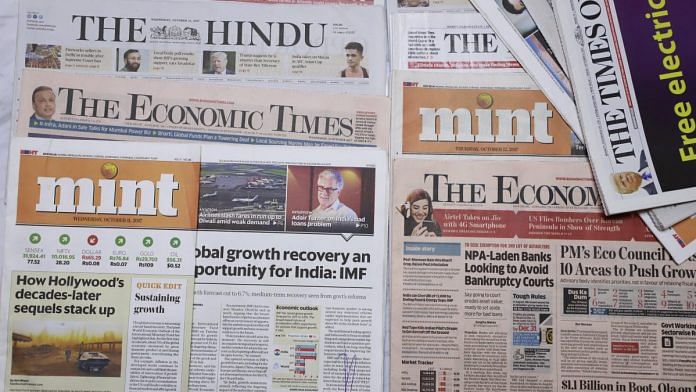A finance ministry office memorandum has ordered that only online advertisements of tenders will be allowed.
New Delhi: The central government has done away with the practice of compulsory publishing of tender notices in the print media – a move that comes as a double whammy to the Indian newspaper industry which is already grappling with spiralling newsprint prices.
An office memorandum (OM) issued by the finance ministry has said that only online advertisements of tenders be will be allowed with immediate effect.
Citing General Financial Rules (GFR) 2017, the OM issued on 8 March says that government tenders above a certain value should be posted on the Central Public Procurement portal, the Government e-Marketplace portal as well as on the website of ministries, departments and other organisations.
Under GFR 2005, all government tender ads were to be compulsorily published in newspapers and magazines. According to the memorandum, it is GFR 2017 that will be applicable now.
Rising newsprint prices
The move will hurt the newspaper industry as it stands to lose a big chunk of its revenue earned from tender advertisements although there are no clear estimates about the amount.
The office memo has also sought from ministries and government departments, year-wise details of expenditure on tender ads issued in newspapers or magazines as well as the number of tenders that have not been advertised in the print media.
Industry sources say this order will be a major setback to newspapers, given that they are already struggling with high newsprint prices.
This central government GFR could also push states to follow the same system although they have separate financial rules, it is feared.
“This is bound to cause a major revenue loss to newspapers, since the tender notices of PSUs and financial institutions are not given out on DAVP rates, but on commercial rates,” said a newspaper proprietor speaking on condition of anonymity. “If these are diverted to digital media, the newspaper industry will hugely be impacted.”
The Directorate of Advertising and Visual Publicity (DAVP) is the nodal body that releases government advertisements at subsidised rates.
I&B ministry to step in
ThePrint has learnt that the Information and Broadcasting ministry has taken note of the finance ministry order and will take up the matter with the latter.
Talking about the problem of high newsprint prices, another Delhi-based newspaper owner said that he could not afford the standard quality newsprint that he bought two years ago since the price has risen to Rs 45,500 per ton from Rs 33,000.
Industry sources told ThePrint that globally, newsprint prices have gone up by more than $200 per ton in the past two years, adding that the rise in newsprint prices was expected, with China beginning to import newsprint of late.
“Previously, China used to have zero import of newsprint, but after the country stopped producing its own newsprint citing environment concerns, it has started importing newsprint. So there is an increasing global demand for newsprint,” a source from the newspaper industry said.
“The cost of newsprint production has also gone up with prices of raw material increasing and several domestic mills shutting down,” the source added.
The current cost of newsprint, the source said, varies from $675 to $750 per ton, depending on its origin, up from $380 per ton in recent years.
Anil Vig, managing director of Anika International, a leading newsprint supplier, said, “The market is volatile and it is difficult to talk about the future right now.”
Meanwhile, a delegation from the Indian Newspaper Society met I&B minister Smriti Irani to discuss the issue of rising newsprint prices.
“She has promised to help the newspaper industry by looking into the aspect of increasing advertisement rates, as the cost of newsprint is one of the indices determining the rates,” a source privy to the discussions said.







Newspapers are struggling in the West, some are going entirely digital. They have had a good run in India, with more and more people reading them, especially in regional languages. However, it is just a matter of time before India is in the same boat. 2. I do all my reading on my iPad, late at night, hours before they arrive in the morning. There was a sanctity to the printed word, especially the edit page. One hopes that will be preserved, even as the medium changes.